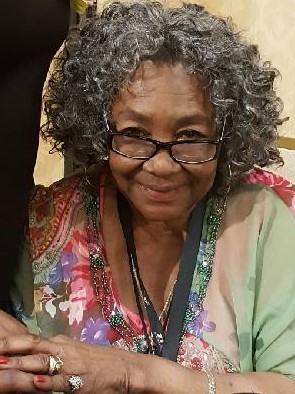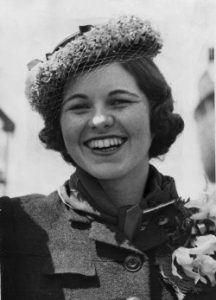Tag: writing about life experiences
The Story Behind the Twirling Tassels: 7 Life Lessons from Lottie the Body

They called her the Gypsy Rose Lee of Detroit, yet exotic dancer Lottie the Body was world famous. Performing during the heydays of burlesque in the 1940s, ‘50s, and ‘60s, she traveled the globe and became a sort of clandestine celebrity. Some people may not have wanted to admit they knew who she was, her being so risqué and all, but they knew. Ask any eighty-five-year-old man if he ever heard of her. If he says “no,” he’s probably lyin’.
Lottie died at age 89 in 2020. She always said that today’s strippers have it all wrong with their “look-at-what-I’ve-got-that-you-can-have” attitude. She insisted it should be “look at what I’ve got that you can’t have,” saying that’s what made it striptease.
“Be a lady. Be classy. Be naughty but never nasty. That’s what made me famous.”
Indeed. Old photos reveal a drop-dead gorgeous African American performer with class galore. It was a combination of looks, talent, and personality that made Lottie a decades-long success on stage. Her costumes were elaborate until she’d peel down to one that was conservative by today’s standards, more than many women wear to the beach these days. She’d start in an elegant gown, take it off to something akin to a sparkly mid-century bathing suit, and maybe, if she felt like it, strip off her top to reveal sequined pasties. The epitome of the act was when she’d twirl the tassels on her pasties, leaving her audience breathless with delight. She was a fabulous dancer and was very athletic, which added to the energy of her show. Audiences – men and women – came to the clubs where she performed to be entertained with a class act, and Lottie did not disappoint.
But there was another thing that made Lottie a truly classy lady: She was a genuinely nice person. I first met her at the Golden Horseshoe “house of burlesque” in Harbor Springs, Michigan, in 1971. I was a lowly twenty-one-year-old college kid waitress, and she was the famous forty-year-old star of the show. I watched the same people – wealthy summer residents, yachters, servicemen, locals, music lovers – come back night after night. Sometimes she’d shimmy her fringed costume, dance like a devilish angel, and merely drop a shoulder strap before exiting the stage.
Oh yeah, they came back. They wanted to see those twirling tassels they’d heard about.
Lottie wasn’t like some of the other performers. She was friendly and chatty with the staff. Even me. She quickly figured out that I was in way over my head in that type of environment – I had to work and that was the only job I could find – and took me under her protective wing. I learned a lot that summer.
She’d worked alongside all kinds of famous people: Sammy Davis, Jr.; B.B. King; Aretha Franklin; T-Bone Walker; Della Reese; Louie Armstrong; the Four Tops; Fats Waller; Sarah Vaughn; Redd Foxx; Cab Calloway; Jackie Wilson; Dinah Washington; and so many more she couldn’t recall all of them. She served as emcee at early Harlem Globetrotters games and was married to Goose Tatum, one of the early players. Before Cuba became a Communist country, she met Fidel Castro and thought him a “sweet little man.” The Philippines’ first lady Imelda Marcos took her shoe shopping. She met civil rights activist W.E.B. DuBois while she performed at the historic recreation community for black people, Idlewild, Michigan. She was best friends with Christine Jorgenson, the first famous transgender American entertainer. Lottie performed all over the U.S., with Alaska being one of her favorite states; throughout the Caribbean; in the Pacific; around Europe; and in northern Africa. All of this and she would help me, a clueless college kid, clean tables at the end of my shift so we could go out to breakfast.
I felt humbled, honored, and happy that such a star would care about somebody like me and treat me as if I were her own daughter. Eventually, she told me to call her Mama Lottie, the nickname she used with her loved ones, and she called me her Baby Boo.
My Mama Lottie, former exotic dancer Lottie the Body, the 2017 Living Legend of the Burlesque Hall of Fame in Las Vegas, was so much more than a body. She embodied the heart and soul of a real woman. We could all, women and men alike, use more Lottie in us. In fact, a lot of Lottie.
So what did I learn from Lottie, the woman who was a second mama to me and a beautiful body to much of the world?
- First of all, not to be ashamed of my body. Although hers was perfection, Lottie always celebrated everybody just the way they were. There was no “I’m the drop-dead gorgeous diva for you to admire;” rather, it was “We’ve all got bodies, so let’s appreciate them.” Everybody felt comfortable around her.
- Secondly, I learned that not all strippers are divas, desperate, or depraved. A few were, but most were not. Certainly not Lottie. I never saw her so much as flirt with a customer. She was a professional who was friendly toward everyone. It seemed as if she was conducting her own kind of civil rights movement that invited everyone to come into her world. Gender, age, race, ethnicity, sexual orientation, religion, abilities, education level, financial status – none of that mattered. What mattered was spending good time together.
- Thirdly, Lottie taught me that dance is an expression of life. She reveled in getting everyone up off their bums to dance. Our favorite night was Thursday, maid and butler night, when the African Americans who worked for wealthy white people at their summer estates in that resort town had the night off. The place was electric! Nobody sat. She’d pull people up on stage; she’d encourage the audience to dance around their dinner tables; she’d jump off the stage and dance in the middle of the crowd. And those were the best tip nights for me, because as maids and butlers they knew the value of hard work. I was usually one of only a few white people in the room on those nights, yet I felt totally included and respected. It was magical, the most fun I’d ever had. And, yes, I eventually overcame my insecurity and shyness and occasionally got up on stage to dance.
- My fourth Lottie lesson was that women should live their lives as they please, not as society or their mother or schooling or a man or the media tells them they should. Well aware there were people who shunned her because of her race as well as her chosen profession – she endured some horrendously bigoted situations in all those years – she focused instead on those who accepted her. She’d experienced many more marvelous times and more good people than frightening times with ignorant cusses, as we called them. We often talked about how more women could benefit from knowing how to find and focus on the good people in this world.
- My fifth lesson from Lottie was that if two people love each other their sex life should be robust. She was married and adored her husband. She didn’t reveal any juicy bedroom secrets to a kid like me, even after many years of friendship, but there was no doubt she enjoyed connubial bliss. Occasionally, she reminded me to do the same, saying a couple’s spat or disagreement should never get in the way of that. And she did have some spicy stories to tell about her younger single days, some very sexy and some quite hilarious. Let’s just say she was not shy.
- The sixth lesson is more general. Enjoy living. Work hard. Laugh a lot. Treasure your friends and family. Eat what you want. Invite new people into your life. Don’t pass up s’mores over a campfire on the beach in the middle of the night. Tell ghost stories. Believe in ghosts and God. And most, of all, treat yourself with respect.
- The final, seventh lesson came in 2019 when I went to Detroit to visit with her after not seeing her in person for several years. We talked on the phone weekly and wrote letters back and forth because she loved letter-writing, but she didn’t travel anymore and I hadn’t been up there in quite a while. Although at age 88 she’d had some health problems, I discovered the same beautiful woman with sparkly brown eyes, velvety skin, and an exuberant personality that I had known for almost half a century. I saw that goodness doesn’t age and kindness never dies.
She once wrote, “Lottie the Body may have brought me fame, but Lottie the Woman has always cared most about one thing: sharing whatever gifts I have to make people happy…. I pray that you may have the same kind of love and happiness that I enjoy. I send my love and God’s blessings to you all.”
In her honor, let’s get up and do a little dance today. And every day after. Let’s celebrate life the way Lottie did – with joy and, most of all, with love.
Postscript: Lottie inspired me to use her stories to write a fictional trilogy, The Burly-Q Girls. It was such an honor to do so. The first book, The Burly-Q Girls: the 6, is now available on Amazon. The others will come out in the spring, The Burly-Q Girls: 6 Dicks, and next autumn, The Burly-Q Girls: 6’ Under, 2022. You can get your copies on Amazon in Kindle, paperback, or large print.
If you want to look her up, simply search for Lottie the Body and you’ll find her. There has never been another like her.
The Three Amigos

I have a handful of best friends. How about you? I think most of us feel close to a few people, not hoards.
Today I want to talk about two of my sister-friends, Myra and Marka. We call ourselves the Three Amigos. We’ve known each other for thirty years and joke that we have to stay friends because we know too much. We don’t want anyone telling our deepest, darkest secrets.
When I first met Myra, we went to lunch one day at a Mexican restaurant. A roach crawled up the wall beside us in the middle of her telling a story. Without breaking stride, she took off her shoe, killed the pest, and went on with her story. I knew she was my kind of woman.
Myra introduced me to Marka, who is ten years younger than the other two of us. Beautiful, stylish, Southern as all get-out, and smart as a whip, I fell in love with her, too, as soon as I met her.
We’re all married, so the husband stories have abounded, as you can well imagine. We love our families but treasure our time together. We meet informally for lunch throughout the year, but it’s tradition to meet before Christmas for a long lunch to exchange small gifts, and then wander through an antique store or two.
It’s this friendship I used as a model for my latest novel, Secrets of the Island. A romantic suspense story, the “Three Musketeers” band together to solve a family mystery. When they solve one, another crops up, so they keep going. It takes place during World War II, so wartime issues intertwine with their lives.
As I wrote, I would think of Myra’s effervescent take on life and Marka’s way of turning a phrase. My characters took on their personalities, with someone a lot like me in the middle orchestrating the solving of the mystery.
I think this is what we as writers do. We don’t disclose our friends’ secrets, but we automatically use who and what we know to write. As I wrote about the Three Musketeers, I fell in love with those characters. Do you as a writer fall in love with some of your characters? I hope so. That’s what will make your readers fall in love with them, too.
This writing also made me fall in love with the Three Amigos all over again. Here’s to sister-friends everywhere. May you stay friends forever, holding those secret stories locked away in your heart.
A Rose is a Rose

 With the two new biographies just out about Rosemary Kennedy, I decided it’s time to share a story about my experience working for her sister, Eunice Kennedy Shriver. Yes, they were sisters in the Kennedy family, thus sisters to JFK, Robert, and Ted. It was 1974 when I volunteered to work at the Special Olympics, which was a new organization with a big event being held on my college campus, Central Michigan University.
With the two new biographies just out about Rosemary Kennedy, I decided it’s time to share a story about my experience working for her sister, Eunice Kennedy Shriver. Yes, they were sisters in the Kennedy family, thus sisters to JFK, Robert, and Ted. It was 1974 when I volunteered to work at the Special Olympics, which was a new organization with a big event being held on my college campus, Central Michigan University.
Mrs. Shriver (I never dared call her Eunice) had founded the Special Olympics out of love for her sister Rosemary. As those of us who worked the three-day event on the track field all knew, Rosemary was what was then called retarded, today called mentally impaired. What we didn’t know at that time and what I learned in subsequent years was that Rosemary’s disability was due to her father having had her lobotomized. It’s a brutal tale for which you’ll have to read the biographies to get details.
But working with Mrs. Shriver was something else. I was a small-town girl in a small-town college with a small-time job. The first time I laid eyes on Mrs. Shriver it was obvious that the silk dress and pearls she wore were more valuable than everything I owned on earth all put together, including my junker of $75 Volkswagen Beetle car. I thought her regal, beautiful, aristocratic… a combination I’d seldom witnessed in my little world. But one thing was clear: her love of the children who were participating in the games. I barely deigned approach her, but the athletes could go to her dirty and sweaty, and hug the heck out of that silk dress and Mrs. Shriver never flinched. They all received her affection.
I fell in love with her. I thought her the most marvelous woman I’d ever met. Today I see her as one of the most influential and important women of the twentieth century for bringing mental impairment out of the closet – literally in too many cases – and bringing human beings with all types of abilities together in a spirit of hope and fun and love.
As luck would have it, my job was to meet celebrities as they arrived and escort them to Mrs. Shriver. It was such fun meeting people I’d seen in the news, including TV and movie stars, athletes, and even Miss America. Out of everyone I met, however, two stood out for their interactions with the kids. Sally Struthers, who was a huge star due to the hit TV show All in the Family, showed up each morning before the kids came. She was there when they arrived and stayed until she’d given every last one of them a hug in the evening. Then she’d go out dancing ’til the wee hours of the morning. I couldn’t even begin to keep up with her. She was great. And singer Mac Davis sat under a tree all day long and taught the kids how to play music with spoons. They loved that. I think we stole every spoon out of the cafeteria in order to handle all the kids who wanted to play. They would go run their meet, then scurry right back to Mac to play more spoons.
There were some celebrities who came just for the photo ops. Once that camera flash popped they were gone.
On the second day Mrs. Shriver’s two children arrived in a limousine. I’m not sure I’d ever seen a limo before that event, so the thought of riding in such a big car was totally foreign to me. When I suggested to Mrs. Shriver’s personal assistant that her children needed some outdoor clothes instead of the proper prep school things they were wearing, he seemed shocked, then considered it. He went to his boss and she looked my way suspiciously. But her assistant eventually came to me with $200 cash and told me to go buy them something more appropriate. I’ll never forget the feel of that cash in my hand. At that time in my life, that was like giving me $2000 in pure gold.
Of course, I didn’t occur to me that they didn’t expect me to take the kids. After all, I’d spent years babysitting others’ children and taking care of my younger siblings, so I was used to being responsible for little ones. And I needed them to try on the clothes. I grabbed Maria, who was about twelve, and her younger brother, who was maybe eight, and we hopped into my $75 Beetle convertible with the broken top and bright plastic flower stickers covering the rips in the seats, and off we went to K-Mart. They loved my car! They’d never seen anything like it. It was the same with K-Mart. They ran up and down the aisles in wonder. It only took a few minutes to get shorts, tee-shirts, and tennis shoes, which they wore with glee. We were back at the track within twenty minutes. When I handed Mrs. Shriver $175 in change she was shocked. She said she hadn’t seen the limo leave and it was then that it became clear to me I didn’t know how things were done in the upper crust.
More and more over the years I’ve come to appreciate how she bravely spoke out about a topic many were embarrassed to acknowledge – the need for services for people with disabilities. I’ve come to understand that she did it out of love for her sister who, according to the recent biographies, she did not know the whereabouts of for many years. When she learned about Rosemary’s fate and that she was sequestered in an institution for the disabled, she visited her beloved sister on a regular basis. It was then that she put her family’s money, privilege, and power to good use to help others with disabilities.
As I said, Eunice Kennedy Shriver was one of the greatest women of the 20th century. We can only hope to have more like her in the 21st.
Writers and Wrongers

 Long ago I heard that title – a woman was describing herself as a wannabe writer who was really a wronger – and I loved it. After periodically seeing that phrase and mulling it over for many years, I’ve come to the conclusion that most writers are probably wrongers, too. I know I am. That’s what makes good stories.
Long ago I heard that title – a woman was describing herself as a wannabe writer who was really a wronger – and I loved it. After periodically seeing that phrase and mulling it over for many years, I’ve come to the conclusion that most writers are probably wrongers, too. I know I am. That’s what makes good stories.
I’ve done a lot wrong in my life. An early college career that had no meaning to me. Giving up on my own hopes and dreams in order to please others. Occasionally falling into the despair of depression. An unhealthy second marriage that resulted in devastation. Being next to homeless except for the generosity of my sister. Assuming someone somewhere would take care of things and it wouldn’t have to be me.
Wow. That’s all great stuff for writing. Ernest Hemingway said, “There is nothing to writing. All you do is sit down at a typewriter and bleed.” That’s what we as writers do. Rather than hiding our most embarrassing, dumb, and inexplicable life decisions, we open ourselves up and let them spill out all over the place. In the process, we figure out what was going on in our minds and what we can do to learn from it. We do this by putting bits of ourselves into each character we write. And by writing characters who are the people we aspire to be.
The reader, of course, never has to know. For example, a villainess in one of my stories, the bitch no one can stand, took a letter that had come in the mail for her friend and steamed it open to see if it was from a guy she herself had a crush on. When it turned out to be from the friend’s dad, she carefully glued it shut and put it back in her friend’s stack of mail. Now I’m not confessing that I ever did such a wretched thing; I’m just sayin’ I got the idea somewhere.
Writers get ideas everywhere. Every time something goes wrong in my life I catch myself saying, “Oh! That would be a good story.” Good stories, after all, are about overcoming life’s obstacles. They are about prevailing. They are about finding an inner strength you never knew was there. They are about discovery!
Although I couldn’t write about it until years later, some of my erratic behavior after the death of my first husband at age thirty-three is revealed in my novel Homecoming Queen. My thankfully short-lived, wacky second marriage can be found in soon-to-be-published Home Body. A trip my sister and I took when we were in our early twenties, where we camped from Michigan to California and back because we wanted to see the Pacific Ocean, is hilarious in Tough Rocks. Although we’d call home and lie through our teeth, telling our parents that everything was “fine,” in truth we ran into a hail storm that demolished the hood of our car; a flash flood that holed us up in Boulder, Nevada, for three days with nothing to do but watch the free movie of how the Hoover Dam was made; a dust devil that destroyed our tent; and melted tires when we drove through the Mohave Desert at noon on the hottest day in July. It’s that kind of adventure that makes for good writing, if you just let it roll rather than refusing to admit you were ever that stupid.
Writer Sylvia Plath said, “And by the way, everything in life is writable about if you have the outgoing guts to do it, and the imagination to improvise. The worst enemy to creativity is self-doubt.”
So if you’re a writer or want to be a writer, go ahead and have the guts to spill out your life stories. Take your wrongs and let them write.
Examples and comments are welcome.
Image found on ruffledblog.com